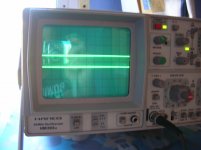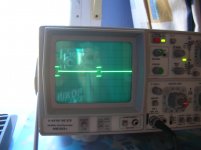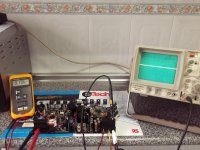Perry: Have you been able to tell what these 4 transistors are doing in this circuit? (their function that is..)
The solder connections on the 4 large SMD transistors in this area fail. For testing, you can sometimes simply solder the connections in place. To make it reliable, the transistors need to be removed, the pads cleaned on the board and the terminals cleaned on the transistors.
Sometimes these transistors become intermittent. I've had at least one that checked bad in the board (open B-E junction) but checked OK out of the board so I'd advise checking them in the board as well as out of the board.
If they're readily available, I'd advise replacing them.
I've substituted TO-220 transistors in a few amps but haven't done enough to know if it's 100% reliable (although it should be). I've used 2N6488s and 2N6491s. The transistor shown is a 2N6491. The rest are NPN and would be subbed with the 2N6488 if necessary.
I think they're voltage regulators. If I'm not mistaken, they have pure DC on them. They're not used for any switching duty.
Well, I've had the four transistors identical to the originals ...
I have replaced, and to connect the amplifier, this is what happens:
At first, everything seemed fine, (0.057 V at the speaker terminals) but when a minute passed, he began to hear a click intermittent (every second) coming from the area of the power supply, at the same time, the current in the speaker terminals, down to 0 V. ....
If I continue applying current to the amplifier, the click intermittent sound becomes long (rrrrrrrrrrrr) and in turn, the power LED flashes .....
Nothing warms, nothing burns ....
Is it weirder ...
Can there be another intermittent connection?
I can? I have moved some component while handling it?
I have replaced, and to connect the amplifier, this is what happens:
At first, everything seemed fine, (0.057 V at the speaker terminals) but when a minute passed, he began to hear a click intermittent (every second) coming from the area of the power supply, at the same time, the current in the speaker terminals, down to 0 V. ....
If I continue applying current to the amplifier, the click intermittent sound becomes long (rrrrrrrrrrrr) and in turn, the power LED flashes .....
Nothing warms, nothing burns ....
Is it weirder ...
Can there be another intermittent connection?
I can? I have moved some component while handling it?
One of these came into the shop yesterday. After I repair it, I'll make a few measurements on various points and get back to you. If I forget and don't post in a day or so, bump the thread.
Do the solder connections on R2035 (large SMD resistor marked 130) appear to have overheated?
If so, apply new solder, desolder and resolder it. Does that help?
If so, apply new solder, desolder and resolder it. Does that help?
Sorry, Perry, no luck ....
I got the R2035, I've checked and I have reinstalled without success.
Is that there is no time to heat up ....
At 30 seconds, the voltage, down to 0V,,,
And continuing a noise near the power supply (rrrrrrrr)
I'll investigate to see exactly where it comes from, this little sound.
Or is there something else I can test, Perry?
I got the R2035, I've checked and I have reinstalled without success.
Is that there is no time to heat up ....
At 30 seconds, the voltage, down to 0V,,,
And continuing a noise near the power supply (rrrrrrrr)
I'll investigate to see exactly where it comes from, this little sound.
Or is there something else I can test, Perry?
If you have a scope, confirm that you have a continuous square wave on the center leg of the power supply FETs. With the scope set to 2ms and 10v/div, you should see a wide trace (~2.5 divisions high) that is unbroken across the display.
Which pins of the SG3526 are pulsing at the same rate as the power supply oscillation pulses on and off?
I was struggling to take measurements ...
When the tension, was down to 0V, and stayed there, I could not make any comparisons with the waveforms ... and I had to wait half an hour, between measurements.
I have found, from pin 9 to pin 18 (pin 1 to pin 8 I could not check them, I'll try tomorrow ...)
The pins that come closest to the waveform found in the center leg MOSFET power supply, are: pin 13 and pin 16, I think, are the outputs, truth, Perry?
Should I check the other pin that I need to know, if indeed, this IC is failing?
When the tension, was down to 0V, and stayed there, I could not make any comparisons with the waveforms ... and I had to wait half an hour, between measurements.
I have found, from pin 9 to pin 18 (pin 1 to pin 8 I could not check them, I'll try tomorrow ...)
The pins that come closest to the waveform found in the center leg MOSFET power supply, are: pin 13 and pin 16, I think, are the outputs, truth, Perry?
Should I check the other pin that I need to know, if indeed, this IC is failing?
13 and 16 are the outputs but that's to be expected.
When do you mean "When the tension, was down to 0V, and stayed there". I understand that tension means voltage but which voltage?
When do you mean "When the tension, was down to 0V, and stayed there". I understand that tension means voltage but which voltage?
Yes, I mean, when I say that the voltage falls to 0V, (usually within 40 seconds of being connected) means longer intermittent, and off the LED.
As I'm checking with the scope, I have connected to the speaker output, the meter, to be watching at all times, the output voltage.
As I'm checking with the scope, I have connected to the speaker output, the meter, to be watching at all times, the output voltage.
The measurements that I needed, from pin 1 to pin 8, are:
Pin 3, 4, 5, 6, 7, 8, give me a very similar waveform to which I gave, the center pin of the MOSFET power source.
What do you think, Perry?
Pin 3, 4, 5, 6, 7, 8, give me a very similar waveform to which I gave, the center pin of the MOSFET power source.
What do you think, Perry?
It appears that your 12v power supply has shut down. How much current does the amp draw?
What's the current rating on the power supply?
What's the current rating on the power supply?
There is a power supply, a battery car is
Is 45 amps, but ... I checked and the truth is a bit low, is 11.50 volts
Can this be significant?
Is 45 amps, but ... I checked and the truth is a bit low, is 11.50 volts
Can this be significant?
Was the voltage measured when the amp was pulsing the power supply drive?
Can you charge it to eliminate this as a problem?
Batteries are typically rated for cold cranking amps (which would typically be much greater than 45 amps) or amp hours. It's not really important here but you should understand which you're looking at on the battery.
Can you charge it to eliminate this as a problem?
Batteries are typically rated for cold cranking amps (which would typically be much greater than 45 amps) or amp hours. It's not really important here but you should understand which you're looking at on the battery.
- Status
- Not open for further replies.
- Home
- General Interest
- Car Audio
- Rockford Fosgate T1500-1 BD


